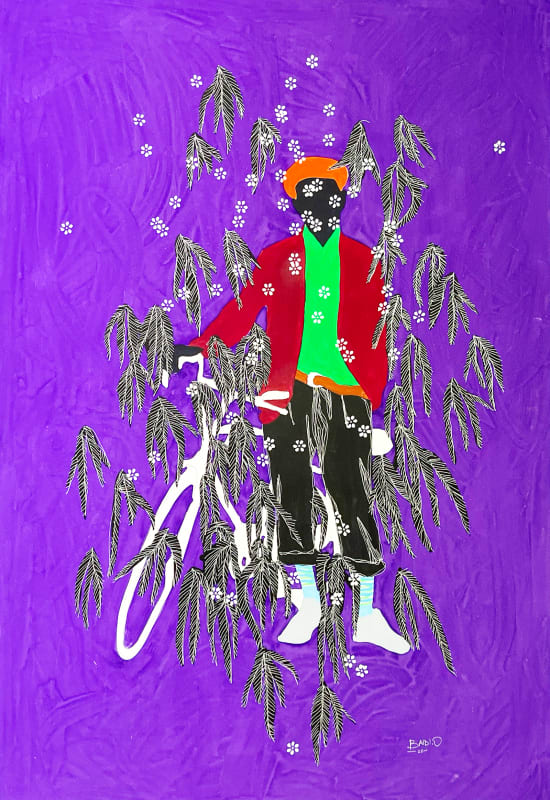Après la pluie narrates the joy of moments of sharing and meditation. Whatever the world's turmoil, the art of Moustapha Baidi Oumarou resists them, praising cohesion rather than adversity.
Colours are at the matrix of Moustapha Baidi Oumarou’s creation. His canvases articulate around one dense pigment that mesmerizes the eye and heals the soul.
Whilst his art aims to produce joy, this new body of work extends this will. Après la pluie (After the rain) is a call to tenderness, love and sharing. Throughout the daily life scenes, Baidi Oumarou reminds that happiness is never far.
The artist imbues his work with sincere optimism. Traditionally associated with the gloom and spleen of poets - an analogy of tears - rain is also a symbol of renewal. Rain nourishes the soil and makes it fertile. Colours bloom as it passes. Petrichor perfumes the air with its reassuring fragrance. The expectation of respite settles in. After all, the rain is only a temporary state, a transitional moment before the arrival of the sun. Metaphorically, it is the hope and joy of a better tomorrow that Baidi Oumarou encapsulates in his paintings. He thus composes a visual promenade to the heart of his utopia. He creates a mirror work, reflecting an idealized replica of the real world in order to lead to change one's perspective. Why linger in the meanders of melancholy when the rainbow dawns through the clouds?
Baidi Oumarou's works precisely embody this rainbow. Composed of the same primary and secondary colours, the pieces unfolding on the white walls of the gallery materialise the young painter's desire to enlighten the world with his art and exalt the beauty of any moment. In Baidi Oumarou's paintings, colours give a glimpse of a dreamy and happy world in which they are invested with healing power. The powerful hues bathe the characters in a halo of benevolence, just as they invite the viewer to figure out a future where acceptance of the other is at the centre of social life. The artist balances between non-colour and intense pigment - leaving black and white predominant. In the manner of Picasso - who appears in the work of Moustapha Baidi Oumarou, sitting in his studio, deep into his thoughts - he paints 'en réserve'. If the Harlequin (1923) by the Spanish master displays the genesis of its creation, the canvas left blank in the work of the Cameroonian artist brings respiration to the imposition of colour. It brings a breath. The artist plays with the composition and leaves room for the viewers' imagination. Their unconscious will colour the void, fed by their own expectations. In the same way, they will project themselves onto the anonymous silhouettes emerging from Baidi Oumarou's imaginary forests.
These faceless figures mirror a universalist vision. Stripped to the extreme to finally be represented only by their outline, the painter provides them with a global identity. Himself a witness to the consequences of inequality, proselytism, and ideological struggles Baidi Oumarou erases any geographical, cultural or religious distinction. By distancing himself from any particularism, he lends everyone the same identity. Beyond considering humans in their individuality, his art speaks of humanity and addresses humanity by establishing new icons.
Thus, Après la pluie narrates the joy of moments of sharing and meditation. Whatever the world's turmoil, the art of Moustapha Baidi Oumarou resists them, praising cohesion rather than adversity.

